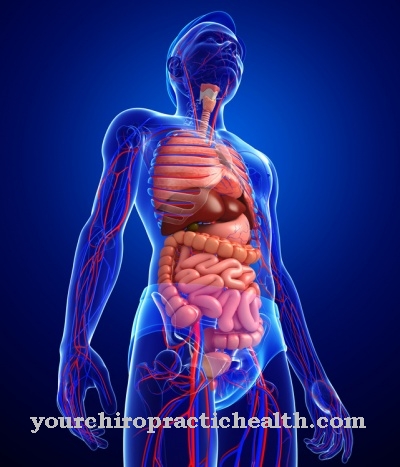Under Fat metabolism, also as Lipid metabolism all metabolic processes are to be understood, which include the uptake and utilization of different lipids. This includes the digestion of fats and fat-like substances, and also the conversion of fats into energy.
What is fat metabolism?

Fats and fat-like substances ingested through food are first emulsified in the stomach and partially broken down. This complex process continues in the liver, intestines, muscles and adipose tissue.
The liver is the central place for the build-up and breakdown of fats. The lipid metabolism consists of an exogenous and an endogenous metabolism. Both serve to supply the organism with triglycerides and cholesterol.
In exogenous lipid metabolism, the fats enter the bloodstream as chylomicrons, i.e. lipoprotein particles, via the lymph. Triglycerides split off from this and are absorbed by muscle and fat tissue. The remaining chylomicrons migrate to the liver.
Complicated transport and restructuring processes take place during endogenous lipid metabolism. A group of lipoproteins, the VLDL, Very Low Density Lipoprotein, are used to transport triacylglycerides, phospholipids and cholesterol into the tissues.
Through conversion, VLDL are converted into lipoproteins of intermediate density, so-called IDL, which are poorer in triglyceride and richer in cholesterol. At the same time, lipoproteins with low density, the LDL, which are also low in lipoprotein triglycerides, but rich in cholesterol lipoproteins, are also formed.
LDL is channeled into the tissue with special receptors. The cholesterol delivered there, along with other fat-soluble substances, is responsible for the synthesis of steroid hormones and vitamin D. Excess LDL is reabsorbed by the liver.
The high-density lipoproteins, called HDL, are also important for protecting the heart and blood vessels from too much cholesterol. Special transport proteins pick up the excess.
Function & task
In contrast to glucose, which plays a central role as an energy supplier for all cells, lipids are only required by a minimal number of cells as a basic supply. The main task of fats is therefore storage.
What the body does not need is stored in the depot. If there is a lack of food, the required fats can be retrieved from the organism thanks to the lipid storage. In this respect, the fats are essential for a well-functioning organism. Lipids provide high-quality energy and warmth and thus supply muscles, cells and organs.
Fats have a variety of tasks and functions. They serve as an energy store for all processes in the body that require energy. As building blocks, they form the basic structure for all cellular membranes. These thin tissue layers made of lipids and proteins separate themselves from external influences in order to maintain the internal environment.
Fats also serve as a synthesis precursor for a large number of biologically active compounds. This includes hormones and hormone-like substances. Triglycerides, cholesterol and fatty acids are absorbed through food. Triglycerides are the actual, important blood lipids that mainly provide energy for fat and muscle cells. They are found in vegetable oils and animal fats.
Cholesterol occurs primarily in foods of animal origin. Strictly speaking, cholesterols are fatty substances and not fats. Cholesterol also supplies the fat and muscle cells with energy, serves as a building block for cell walls, is involved in building up the nerves, in the formation of sex hormones, in the production of cortisone and heart-stimulating substances, contributes to the synthesis of vitamin D and is an important factor for the formation of bile acids. These play a central role in fat digestion and excretion.
Fatty acids, which include both saturated and unsaturated, are found primarily in vegetable fats. They provide energy, support the immune system, are involved in numerous other metabolic processes and can alleviate depression. Lipids also play a role in enzymatic reactions.
Illnesses & ailments
Fat metabolism disorders are widespread in the western world. The reasons are an unhealthy lifestyle and a diet high in fat and sugar. However, genetic predisposition also plays a role.
Vascular and cardiovascular diseases occur in particular in industrialized countries. The causes here are a diet that is too high in calories, combined with a lack of exercise. Lipid disorders can be determined by an increase in blood lipid levels.
A fat metabolism derailment occurs when the transport, processing and production of lipids no longer function properly. Lipid disorder is divided into two categories, primary and secondary.
The primary form is a genetic disease. In the case of congenital lipid metabolism disorders, fat deposits in the skin can already be observed in childhood. Cholesterol levels are significantly increased and patients develop vascular calcifications even in childhood.
In the secondary form, there are usually underlying diseases such as diabetes, obesity, stress or thyroid dysfunction. The consequences are the same for those affected by both forms. There is an increase in the total proportion of fat in the blood, a disruption of transport and blood fat processing.
An increase in blood lipid levels is one of the most common lipid disorders and is divided into two categories: high cholesterol levels and high triglyceride levels. Unlike the triglyceride, the body produces cholesterol itself and is therefore hardly dependent on the intake of food. Due to the large number of foods containing cholesterol, the intake has risen sharply and the excess can no longer be broken down.
The primary, genetically determined lipid metabolism disorder usually results in an increase in cholesterol. While the secondary form leads to an increase in triglyceride levels.













.jpg)

.jpg)
.jpg)











.jpg)